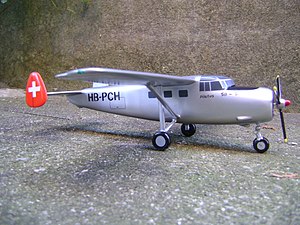Pilatus SB-5
| Pilatus SB-5 | |
|---|---|

|
|
| Type: | STOL multipurpose aircraft |
| Design country: | |
| Manufacturer: | |
| First flight: |
Never |
| Number of pieces: |
0 |
The Pilatus SB-5 was a development project from 1944 by the Swiss company Pilatus Flugzeugwerke AG and the ETH Zurich , but no aircraft was built by it. The name Pilatus SB-5 is composed of the aircraft manufacturer, the Pilatus Flugzeugwerke, the abbreviation SB stands for Swiss mountain aircraft.
history
In the winter of 1941, construction of the Pilatus SB-2 special aircraft began. The Pelikan was designed as a " slow plane ". For use in narrow Alpine valleys, short take-off and landing stretches as well as very good climbing performance were required. The Pilatus SB-5 was a project for an enlarged version of the Pilatus SB-2.
construction
The entire layout was the same as the SB-2. The SB-5 was a single-engine shoulder- wing aircraft with a rigid nose wheel landing gear . The SB-5 was also developed from the start as an aircraft with a metal fuselage. Apart from the larger dimensions, the differences were as follows: The wings now had no sweep instead of the negative sweep and the drive consisted of a Cyclone radial engine instead of the Wasp Junior engine and a three-bladed propeller instead of the two-bladed propeller. The three-blade propeller with an adjustment device from Escher-Wyss was also intended as a brake propeller. The cabin should now accommodate 9 people, 6 on 3 benches and 3 on 3 seats on the other side of the aisle, and the cargo hold and the cargo hold flap would also have been larger. With only one pilot, there would have been room for a passenger in the copilot's seat. Since the hoped-for commercial success was not achieved with the SB-2, and since the end of the Second World War, massive numbers of former military aircraft were being offered cheaply in Europe, it was unlikely that the Pilatus SB-5 would find buyers. Therefore, the project was terminated before construction began. The production of the SB-5 was planned at the Pilatus works, so this aircraft would have been called the "Pilatus SB-5". The Pilatus SB-2 was called "Pelican"; it is not certain whether the SB-5 would have been given the (official) designation "Super-Pelican". Based on the plans for the Pilatus SB-2, it can be assumed that the rigid landing gear with wide runners for take-offs and landings on snow fields or swimmers could also have been installed on the Pilatus SB-5.
Aircraft data
- Crew: 2 pilots / 9 passengers or 1 pilot / 10 pass.
- Span: 22 m
- Maximum weight: 5 t
- Wing area: 55 m²
- Powerplant: 1 × Cyclone radial engine , 1000–1200 PS
- Maximum speed: 250 km / h
"SB" projects
- The SB-1 project was intended as a purely experimental aircraft; commercial use was not intended.
- The Pilatus SB-2 was the only self-service project that resulted in an aircraft that was actually built and flown.
- Nothing is known about any designs with the designations SB-3 and SB-4.
literature
- Pilatus SB-2 Pelican: The Swiss Mountain Airplane 1938–1949 . Study office for special aircraft, Kuno Gross, ISBN 978-3-7494-3640-8 .
- Roland Eichenberger: Pilatus Aircraft: 1939–1989 , Pilatus Aircraft Works , Stans 1989.
Web links
- Drawing of the Pilatus SB-5 on the external page
- Pilatus Aircraft: Projects
- History, planning of the Pilatus SB-2 ETH library.
Individual evidence
- ^ Pilatus SB-2 Pelican: The Swiss Mountain Airplane 1938–1949. Study office for special aircraft, Kuno Gross, ISBN 978-3-7494-3640-8
- ↑ Photos SB-2 with runners.